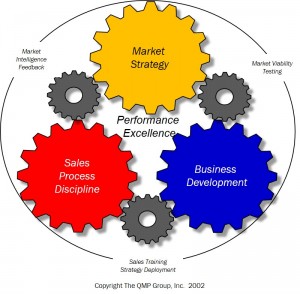Here is a reprint of a recent interview Jerry did with Kevin Price, author, publisher and radio host for the “Price of Business”. Kevin is a syndicated columnist, both writing for the Huffington Post and appearing on Fox News. The interview explored professional approaches to reaching the CEO of small to midsized firms.
Price: Tell me about your firm (number of employees, location, type of companies you work with, etc.).
The QMP Group, Inc. is a Portland-OR-based management consulting firm whose mission it is to help small to mid-size, Business-to Business firms increase their market valuation. We accomplish this by helping them adopt the rigor and disciplines of the QMP (Quality Marketing Process) methodology. That methodology is embodied in our Marketing & Sales Engine model. We install, repair, replace, align or supercharge whichever of the gears need attention.
While The QMP Group itself operates periodically with only one or two employees, we service a wide range of our clients’ needs through close collaboration with highly qualified and experienced consultants of other complementary specialties: Finance, Organizational Development, IT, Operations, Supply Chain Management and Manufacturing.
Price: Tell us your story about reaching C-Level executives to do business?
I started reaching C-Level executives through Thought Leadership, that is, sharing my insights on market strategy through public speaking and writing for business journals. Basically, I was driven to passionately share my beliefs on the subject of the overriding importance or market strategy. I believed then, as I do now, that there is no more important management function than formulating a good market strategy, for the well-being of all stakeholders in a firm: the employees and their families, owners, shareholders, suppliers, customers and the community in which the business resides.
In the early days of my consulting practice I would give a talk at venues where CEOs convened to hear about specific topics of interest. I would give my talk and folks would walk up to me afterward, hand me a business card, and say, “That’s real interesting stuff. I think it might be able to help us. Please give me a call to arrange a time to get together and talk.”
Those introductions led to client engagements. Engagements led to client successes, and successes led to CEO-to-CEO referrals. QMP’s business is still largely maintained through talks and referrals.
One more point about talks. I call talks “Networking from the front of the room”. How else can you get 20 to 80 CEOs and Executives to give you their undivided attention for 45 minutes (with 15 minutes for questions afterwards). Not only that, whoever is sponsoring the venue does all the prep work: food, invitations, scheduling, room set up, etc. There is no more efficient way to reach Executives and CEOs en masse.
Of course, we are not talking about a 45-minute sales pitch here. There is no quicker way to destroy your reputation and credibility as a Thought Leader than trying the hard sell in a talk about insightful business practice. We are talking about a sincere exchange of insights that will help the listener.
Price: Do you know of other examples of businesses being creative in this endeavor?
Let me answer with a story. Several years ago our local chapter of the Institute of Management Consultants convened a members-only working session for the purpose of sharing our personal stories about what we attributed out personal consulting success to. Most of us in the chapter work with the CEOs or high level execs in our client firms.
Naively, I thought that all would say the same thing that I said, namely Thought Leadership – leading to CEO-to-CEO or advisor-to-CEO referrals.
As we went around the room giving each member a chance to tell their own story, I was amazed at the variety of “secret ingredients” of success in reaching CEO’s. Some said their personal network, some said referrals, some said their coaches driving them, some said, believe it or not, cold-calling! Being an engineer I became fixated with finding what could possibly be the common thread in such a diverse set of paths-to-success – and here’s the conclusion I arrived at.
In each case, what the consultant was really saying is, “This is what has worked for me, because this is who I am – naturally.” The individual who said networking is well known in the organization for having and staying connected to a personal and professional network that rivals God’s. The individual that said cold-calling teaches sales and cold-calling techniques for a living.
What I am saying here is that, a person’s path to connecting with a CEO inevitably follows the path of, and leverages, who they naturally are. It builds on what their natural affinity is and how they have channeled it.
A final note on this point: Once you have made your first CEO contacts and built first level successes – the referral machine (CEO-to-CEO or advisor-to-CEO referrals) takes over a fair share of the burden of CEO introductions.
Price: What lessons, if any, do you derive from these stories?
Great Question! Find out who you really are. Discover the thread in your life that is constant, and I believe you will find that it has consistently driven your past successes. Find it then extrapolate it. If that all sounds too esoteric, talk about it with a personal or business coach about your search for the thread. Strengths Finders (the book and the self-assessment) are very helpful. Here’s a link http://strengths.gallup.com/default.aspx.
Remember, your first CEO success can create a flywheel of CEO referrals. So give it all you’ve got. Leave nothing on the field.
Price: Tell us why it is important to for you to pitch to the CEO.
The owner of a privately-held firm is typically its CEO. The firm’s market value is connected directly to that owner’s wallet and net worth – and that individual’s personal wealth (short and long term), and the future of his or her family, are tied to market valuation of the business. Decisions about how to invest to increase that valuation are exclusively the realm of the CEO.
In addition, we are typically executing business process and organizational transformations in our engagements. These process changes have broader and longer term implications on employees, customers and owners, than say, paving the parking lot. The CEO must be involved and actively participate.
Price: What are some unique things you have done to get the attention of CEOs?
CEO’s trust their peers and their advisors. As a consultant, a CEO is not likely to quickly trust you, because they don’t know you. So, getting to CEO’s usually requires a bank shot of trust. A referral from a CEO’s advisor or respected peer is that bank shot of trust.
In turn, for a referral to be made to a CEO by an advisor or peer, that advisor or peer needs to: a) trust you and, b) believe in your expertise, either through personal experience or reputation.
Consultants accomplish this transfer of trust by either; a) demonstrating a track record of success that the CEO’s peer or advisor has witnessed firsthand, or b) building their reputation as substantive Thought Leaders, i.e. speaking and writing on topics germane to the CEO’s circumstance. Those written opinions, talks and successes need to be insightful and substantive.
Your track record and reputation as a Thought Leader, in the minds of a CEOs peer or advisor, is your CEO magnetism.
Price: Tell us about the type of companies with which you like to do business.
We prefer to do business with firms with CEO leaders that are,
1) open-minded,
2) decisive,
3) foster a company culture of accountability and expectations and
4) actively participate in the business.
Formulating an improved market strategy takes knowledge, expertise, analysis and creativity, but more importantly, execution takes real leadership. So, I guess, I am saying the type of leader is more important than the type of company.
Price: What suggestions do you have for others trying to reach CEOs.
Become a Thought Leader. Write, blog and speak to CEOs and CEO advisors.
Build Your Trusted-Advisor Referral Network: Research into how ideas and innovations diffuse into a market place indicates that intra-market network communications (peer-to-peer, or trusted-advisor-to-peer communication) is 13 times more effective in the spread of that idea than mass communications.
Make sure your network knows how to recognize clients you can help:… and, don’t be shy to ask for referrals
Treasure, Preserve, Respect and Thank that Network: Stay in communication, acknowledge and appreciate former clients, advisers and referrers.
Always Act in the Best Interest of Clients: Trusted advisors are trusted because they are transparent and the CEO believes that they are acting in his best interest. Sublimate your needs to the client’s best interest in all that you do. That reputation will me your badge of behavioral honor.
Document your Successes: Measure and record the indicators of your success – and assure they can be validated by references from that engagement
*******
